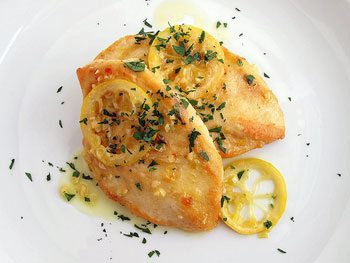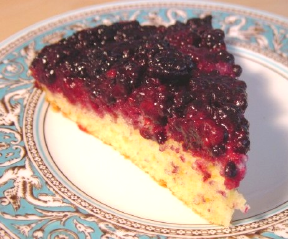 Italian food isn't just all about pasta and tomato sauce. Much of it is
simple and rustic home-style cooking, like simple sautes and slow
braises. The recipes I like the most are both simple and elegant, such
as scaloppine, which involves cooking thin pieces of meat. All that the
word scaloppine means is thin piece of meat. Veal or chicken are
commonly used in classic recipes. The meat is breaded, fried, and then
served in a sauce, such as a piccata, which features white wine, capers,
and lemon.
Italian food isn't just all about pasta and tomato sauce. Much of it is
simple and rustic home-style cooking, like simple sautes and slow
braises. The recipes I like the most are both simple and elegant, such
as scaloppine, which involves cooking thin pieces of meat. All that the
word scaloppine means is thin piece of meat. Veal or chicken are
commonly used in classic recipes. The meat is breaded, fried, and then
served in a sauce, such as a piccata, which features white wine, capers,
and lemon.
What's great about a recipe like scaloppine is that it's great for
dinner for two or a large family gathering. It's a perfect dish for a
quick weeknight meal because it's fast and easy. I update the classic
recipe by replacing the breading with just Wondra flour. The low-protein
flour creates a brown exterior that's light and just thin enough so as
not to get soggy. Plus I don't add the chicken to the sauce. This way
the coating stays crisp as long as possible. Simply serve the sauce
spooned over the chicken and enjoy it right away.
Retro Recipes and Traditional Fare
Retro Recipes and Traditional Fare
Blackberry Upside Down Cake
 When a wine is described as "jammy" I always think of blackberries. Rich, ripe, fruity flavors so intense they almost taste more cooked than fresh. Blackberries, when fully ripe and sweet, not sour, taste like jam to me. Jammy also means "lucky" according to an Australian English dictionary I recently consulted. I think one slice of this cake will make you feel very lucky indeed! I certainly feel lucky to have gotten the berries from my friend Alton who brought them back from his mountain cabin hideaway, Shadow Woods.
When a wine is described as "jammy" I always think of blackberries. Rich, ripe, fruity flavors so intense they almost taste more cooked than fresh. Blackberries, when fully ripe and sweet, not sour, taste like jam to me. Jammy also means "lucky" according to an Australian English dictionary I recently consulted. I think one slice of this cake will make you feel very lucky indeed! I certainly feel lucky to have gotten the berries from my friend Alton who brought them back from his mountain cabin hideaway, Shadow Woods.
I'm assuming since you are visiting this site, that you probably use the internet to find recipes. I sure do. One thing I particularly find useful are the reader comments. For example the recipes on Epicurious often have suggestions from readers on changes and improvements they have made to the posted recipes. Sometimes their suggestions make sense, though not always.
This recipe started out as one I found online, but based on reader comments, a little experimenting, and ultimately my own experience I made it my own. How different is it from the original?
Summer Corn Vichyssoise
 Whenever I fire up the grill, I always grill corn. I think it makes the perfect summer side dish eaten right from the cob with nothing, not even salt. But often enough after a family dinner, especially the one this past Labor Day weekend, I find myself with a few leftover ears. I'm always trying to come up with new ways to use the corn. I slice it from the cob and use it in rice dishes, in salsas, or make a succotash. But one of my favorite ways to use leftover corn is in a chilled soup.
Whenever I fire up the grill, I always grill corn. I think it makes the perfect summer side dish eaten right from the cob with nothing, not even salt. But often enough after a family dinner, especially the one this past Labor Day weekend, I find myself with a few leftover ears. I'm always trying to come up with new ways to use the corn. I slice it from the cob and use it in rice dishes, in salsas, or make a succotash. But one of my favorite ways to use leftover corn is in a chilled soup.
Here I reimagine the classic French chilled soup, vichyssoise, with the addition of corn. The base of leek and potato is still the same. It's very mellow, but once the corn is added, it brightens and sweetens the soup. My secret ingredient is a sprig of lemon thyme, which adds a citrusy woodsy note. The soup could also be eaten hot, but why not have a bowl of cold soup during the dog days of summer? It's thoroughly refreshing, savory, sweet and most of all cooling.
The Perfect Paella
 A couple of summer months filled with many beachside lunches of paella so good and so long ago that I am still chasing the memories of a perfect paella. My sister and I were in the Catalonian village of Arenys de Mar for a good part of the summer. On the wide, white beach surrounded by rugged hills were a handful of rustic 'restaurants' that made only paella over wood fires. They were makeshift structures covered with bright pieces of miss-matched canvas tacked down to keep the strong Spanish sun and ocean breeze at bay. These little makeshift restaurants were always busy for lunch, the only meal that they served and I had my favorite one.
A couple of summer months filled with many beachside lunches of paella so good and so long ago that I am still chasing the memories of a perfect paella. My sister and I were in the Catalonian village of Arenys de Mar for a good part of the summer. On the wide, white beach surrounded by rugged hills were a handful of rustic 'restaurants' that made only paella over wood fires. They were makeshift structures covered with bright pieces of miss-matched canvas tacked down to keep the strong Spanish sun and ocean breeze at bay. These little makeshift restaurants were always busy for lunch, the only meal that they served and I had my favorite one.
The beach side paella restaurateurs were waiting like gulls as the little boats motored back to port around 10 o’clock in the morning. Each boat filled with the fresh caught fish and shellfish still moving violently seeking to be set free. There was fish to fillet and chunk, stock to make, onions and peppers to chop and most importantly the wood-fire had to be started, time was of the essence.
My favorite restaurant had a round stone fire pit built on the sand. A variety of wood collected from the beach was piled into the pit covering yesterday's scrunched up newspaper which was barely visible in the center. A wooden match was struck and the day's cooking commenced. When the flames burned down, the cook balanced a grill on top of the stone pit.
Sour Cherry Cake
 Sour cherries are revered for their tart taste, aroma, and flavor. They're a special fruit with lots of versatility in both sweet and savory recipes. In Hungary, sour cherries are king in early summer. They're too tart to enjoy fresh, though some people do eat them that way. Sour cherries are much better in recipes: tarts, pies, cakes, compotes, brandied cherries—these are some popular recipes. Here in the States sour cherries are pretty rare and hard to find, and their season is short, but they are in season now. If you look hard enough you'll find these red jewels in farmers' markets, especially on the East coast.
Sour cherries are revered for their tart taste, aroma, and flavor. They're a special fruit with lots of versatility in both sweet and savory recipes. In Hungary, sour cherries are king in early summer. They're too tart to enjoy fresh, though some people do eat them that way. Sour cherries are much better in recipes: tarts, pies, cakes, compotes, brandied cherries—these are some popular recipes. Here in the States sour cherries are pretty rare and hard to find, and their season is short, but they are in season now. If you look hard enough you'll find these red jewels in farmers' markets, especially on the East coast.
I love sour cherries in every which way, especially in sweet recipes, like pie and even soup. When I was a kid my mom would make sour cherry cakes and tarts, but she almost always used canned or jarred cherries, because it was difficult to find fresh ones. Luckily for me, I picked up two quarts of sour cherries at Cheerful Cherry Farm at the Union Square Greenmarket this past week. Immediately all the possibilities of what to make swirled in my mind. But I knew that making a sour cherry cake like my mom's would be the perfect choice.
More Articles ...
Welcome to the new One for the Table ...
Our Home Page will be different each time you arrive.
We're sure you'll find something to pique your interest...


